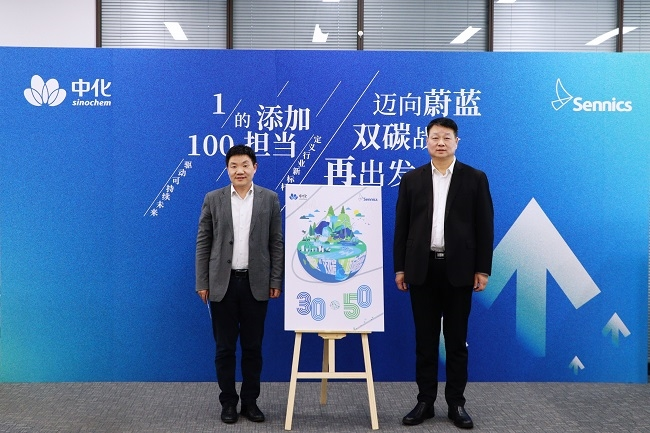On the morning of March 20, the SBU of Additives announced at a ceremony taking place at Sinochem International Plaza that Sennics will upgrade its strategy of "Embracing the Dual Carbon Goals for a Bluer Sky" to become carbon neutral ten years earlier in 2050. Top leaders who were present at the ceremony to unveil the upgraded strategy include Chen Hongbo, Vice President of the SBU of Chemicals, and Party Secretary and Chairman of Sennics, and Gao Shiming, CEO of Sennics.

Chen Hongbo said that moving the goal of becoming carbon neutral ten years earlier was not for numbers only, but a response to the challenges of our time. Given the rapid industrialization across the world today, pursuing green development is the only way out. He said that the company must abandon its traditional profit model that relies on economies of scale and efficiency to regain a competitive edge through green innovation. According to him, the company will achieve this in three steps:
The first is to empower green production through technological innovation. The company will improve its capabilities across the board focusing on green technologies, to lower its energy intensity and emission factor and build a competitive edge by adopting innovative technologies and upgrading equipment.
The second is to optimize its energy mix and cement a low-carbon foundation. The company will accelerate its energy transition, increase the use of green electricity, and reduce total carbon emissions. It will also explore efficient and low-cost ways to adopt hydrogen in an effort to achieve the diverse and sustainable utilization of energy.
The third is to explore alternative materials and open a new chapter for green development. The company will deepen the research on the application of bio-based materials and increase their use in production, to make its products more competitive in terms of green raw materials used, and to drive the green upgrade across the industry's value chain.
Gao Shiming set out four requirements on sustainable development:
The first is to come up with a well-thought-out plan and have it implemented in an orderly manner. The company should come up with a plan for sustainable development that is formulated in a step-by-step fashion with the priorities being highlighted. Such a plan should be made closely aligned with the company's reality and based on a thorough study of domestic and international market situations.
The second is to reduce energy consumption and costs through measures appropriate to local situations. Each factory should enhance the integrated utilization of energy in accordance with the resource endowment and energy condition in the region where they are located. They should initiate an internal campaign to reduce energy consumption, and to improve energy efficiency and economic performance.
The third is to drive technological innovation and improve energy efficiency. The company should reduce energy intensity through technological tools, drive transformations in the energy sector, and promote the industry's green and efficient development.
The fourth is to take a strategic approach and reduce carbon emissions in a scientifically sound manner. The company should make sustainable development a part of its core strategy, come up with a comprehensive, systematic and detail-oriented plan, optimize decarbonization measures in a targeted manner, and take solid steps to have them implemented.